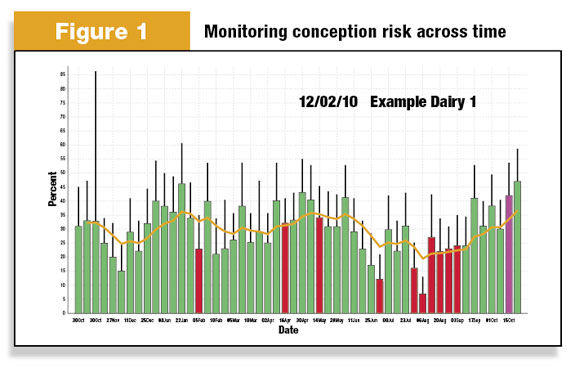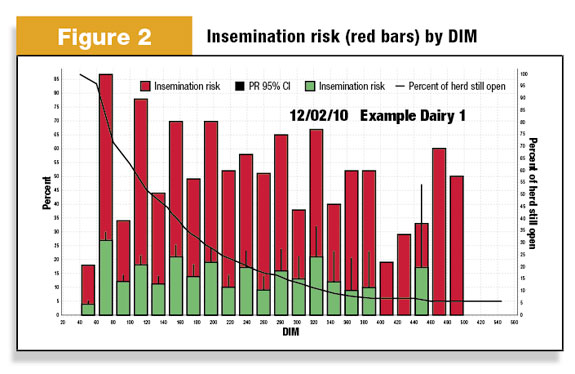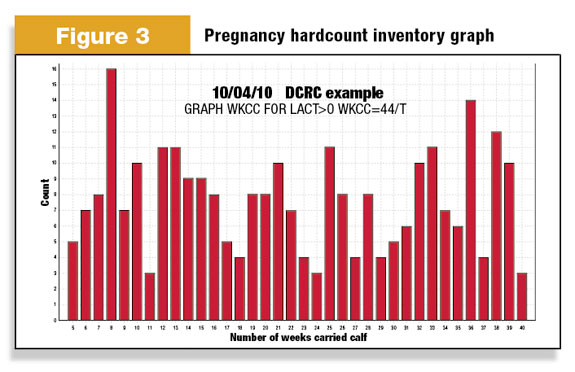Despite all of the advances in technology and synchronization protocols in recent years, many producers still find themselves struggling to consistently achieve high reproductive performance. Although attributing mediocre results to genetics or high production is interesting conversation, as managers and consultants, we are continuing to learn how to improve reproductive profits through effective monitoring of data, optimization of cow comfort and transition programs.
What’s possible and what are economic considerations?
A 2010 study reviewed reproductive performance on dairies to establish current capabilities and practices on U.S. dairy operations. The study included records from 85 Holstein herds, representing 231,288 cows and 649,495 inseminations with known outcomes during the previous year.

This study revealed some encouraging findings ( Table 1 ). The top herds far surpassed what was believed to be “normal” in both conception rates and pregnancy rates. Further, only small differences in conception rates were observed regionally regardless of TAI or A.I. after detected estrus.
Economic opportunities should be calculated using a reproductive model ( http://dairymgt.uwex.edu/tools.php#1 ) to compare estimated differences in lactation costs, calf losses, culling and program expenses. These values can be used to assist decisions before changing a program to incorporate new protocols or methods.
Which metrics and how to interpret them?
In the simplest form, the goal of all reproductive programs is to maximize the production of quality pregnancies during a specified time period with minimal variation and waste. Producers whose herds show high reproductive performance use a handful of metrics to evaluate and manage their programs. Some fundamental metrics include:
Pregnancy rate (PR) is accepted as the gold standard to measure pregnancy production per specified time period (usually per 21-day period). Producers using both A.I. and natural service must measure all three components (A.I., bull and whole-herd PR) separately, yet understand that whole-herd PR is what ultimately determines the economic impact of the program on total herd profitability.
Many producers and consultants have been overly confident about reproductive success in recent years by only looking at their A.I. pregnancy rate success.

Conception risk (CR) represents the proportion of animals that become pregnant in relation to the total number inseminated. Producers should evaluate CR trends across time ( Figure 1 ) and be sure to monitor differences between parity to detect possible grouping and nutritional opportunities.
Likewise, evaluating CR by sires, technicians and A.I. type (i.e. chalk, TAI, etc.) is important to detect opportunities within each respective aspect of the program.
One of the largest obstacles in evaluating CR on most commercial dairies results from normal variation (binomial) and requires more than 300 observations (breedings) to accurately compare two CR values. Producers can reduce variation and ease evaluation by limiting sire choices to less than six, technicians to one to two, and A.I. types to two to three within a three-month to four-month time period.
Insemination risk (IR) is also known commonly as heat detection rate or submission risk and represents the proportion of eligible animals inseminated (A.I. programs) compared to the total number of animals eligible. Dependent upon the type of detection programs in place on your dairy, IR can be influenced by cow factors, facility design or management protocols. Examples might include:
- Cow factors – energy balance, cow comfort, foot and leg problems
- Facilities design – flooring surfaces, lockups or restraint systems, stall design, heat abatement systems
- Management – TAI protocol, herdcheck frequency, lack of training or time allocation and overstocking pens
Over time, many herds have increased their reliance upon TAI for the majority of their inseminations and concurrently reduced (or eliminated) their focus on accurate detection of heats with chalk or visual methods. As a result, these herds are increasingly reliant upon CR to drive their pregnancy rate to new levels, since open animals are often not detected until pregnancy diagnosis.

The alternate cycle effect, in which insemination risk oscillates from higher to lower to higher and so on ( Figure 2 ) may represent significant economic opportunity compared to successful implementation of both detection and TAI systems together.
As a result, routine monitoring of the percent of total inseminations which are TAI can be valuable to track efficacy of both heat expression and detection systems.
Pregnancy inventory is a simple inventory management tool that monitors the number of pregnancies produced each week or month ( Figure 3 ).

The importance of this metric is related to the fundamental need to continually have a predetermined number of pregnancies in order to generate future revenues.
In addition to obvious usefulness to a dairy’s financial consultants, producers commonly use the pregnancy inventory to manage pregnancies from both youngstock and adults during seasonal challenges like heat stress.
Cows open more than 300 days in milk (DIM) are a substantial financial cost to the dairy operation. Monitoring the percent or number of animals open more than 300 DIM has become more commonly used as an outcome metric to monitor the economic effectiveness of extended voluntary waiting periods and re-enrollment programs.
Regardless of the exact cutoff used, a high percentage of animals with long days open should be considered imminent reproductive culls.
Blood progesterone monitoring
One revealing finding from the aforementioned 2010 study was that more than 60 percent of inseminations in one of four regions of the U.S. were classified as TAI inseminations (average of 43 percent across all regions). With such a high percentage of TAI inseminations, it becomes crucial that producers routinely monitor their synchronization efficiency and that greater than 85 percent of enrolled animals are cycling (and capable of becoming pregnant).
Progesterone sampling can be used on both blood and milk to ensure synchronization efficiency, although blood progesterone is the preferred quantitative test. Costs for blood progesterone samples are approximately $6 per sample, or a total cost of less than $250 to monitor the entire TAI program.
Likewise, the 2010 study revealed that in two of four U.S. regions, more than 75 percent (average 56 percent across all regions) of inseminations were classified as detected (chalk, visual or other aid). Blood progesterone should also be used routinely in this population to validate accuracy of heat detection.
Summary
Producers and consultants need to reset their reproductive goals to meet the higher capabilities we now know are possible on commercial dairies. Using available models will allow producers to establish an economic value on improving the reproductive program and prioritization within the needs of the dairy.
Lastly, producers should choose a small number of fundamental metrics to monitor reproduction and take advantage of technologies like blood progesterone and BHBA testing to ensure consistency and reduce variation of their reproductive results. PD
References omitted due to space but are available upon request to editor@progressivedairy.com .

-
Neil Michael
- Director of Dairy Initiatives
- Vita Plus Corporation
- Email Neil Michael






